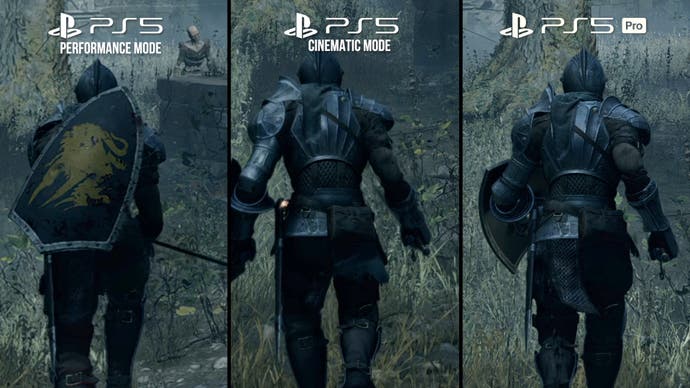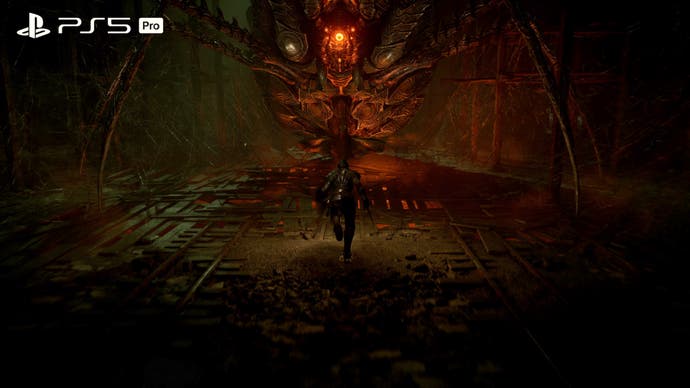Following its announcement earlier this month, we’ve had a chance to go hands-on with the PlayStation 5 Pro at a Sony event in San Francisco. With a rapid nine-minute reveal and little additional information made available after the fact, this is our first look at the new hardware, PSSR upscaling and 11 upgraded PS5 Pro titles in the flesh. Going in, the questions were simple: is the premium $699/£699 price point commanded by the PS5 Pro justified? Does the pro console deliver a genuine upgrade in terms of frame-rates, image quality and visual features?
That’s a complicated calculus for sure, but getting to actually sit down and play these PS5 Pro games has made the argument better than the reveal trailer and spec sheet has. In my mind, this is akin to a big graphics card upgrade for a gaming PC – you can suddenly enable new features that you couldn’t before, and you also enjoy a general uptick in performance that makes your existing games more fun to play. This goes double if you primarily played your PS5 games in performance mode when given the option, as you’re keeping the same 60fps update rate in most cases but image quality takes a gigantic step forward – and you may get some new ray tracing features in the bargain.
Before we get into the fundamentals of the value argument, it makes sense to cover the games that we had a chance to play at the three-hour press event. There were some games that felt a bit by-the-numbers in terms of upgrades, but there were also surprising and genuinely exciting demos that best sold the idea of the PS5 Pro.
The first game is not one you might expect: F1 24. Codemasters are continually pushing visual features on the PC version, despite the yearly release cadence, and there is therefore a lot of rendering technology that can be used for the PS5 Pro. The headline here is that the PS5 Pro has enough grunt to deliver a 4K 60Hz quality mode with multiple RT effects – DDGI (dynamic diffuse global illumination, previously seen in the PS5 version), plus RTAO, RT transparency and RT opaque reflections. In the right circumstances, this is an almost generational leap in image quality.
A lot of these improvements come in the form of improved indirect lighting, with a lot of additional lighting detail visible on the PS5 on the shaded streets of mid-afternoon Monaco. Reflections now encompass cars, track-side detail and even transparent surfaces in that track-side detail. This isn’t new – we’ve seen these features on the PC version – but it makes the game look much closer to the F1 broadcast that fans will be familiar with.
The RT mode, as well as delivering all of the RT features from the PC version besides RT shadows, also includes improved anisotropic filtering (AF), which improves the visuals as well. The RT mode isn’t as stable as PS5 on quality mode – likely due to a combination of PSSR limitations and the noise inherent to RT effects – but the trade-off is absolutely worth it.
There’s also a 4K 120fps mode, which sacrifices RT features to maximise image quality and frame-rate. Indeed, this also maximises the HDMI 2.1 standard, and replaces the earlier 1440p 120fps mode.
Finally, the promise made by side of the PS5 box is (kind of) realised: there’s an 8K 60fps mode which pushes image quality to the maximum and still includes DDGI. Interestingly, the 8K mode drops into 8K 30fps for replays and adds on all of the RT features from the PC build, including RT shadows, that don’t appear in the 4K 60fps mode.
The 8K mode isn’t native 8K, but it actually isn’t using PSSR yet – it’s using the Ego Engine’s native TAAU instead. Simon Lumb, a producer at Codemasters, said that they hadn’t gone through too many iterations of their PSSR implementation, but they are looking to include it in the future and they expect that as “it’s tuned to console hardware, it’s going to get better and better over time.” He also added that “it’s going to go into our engine”, so it ought to make an appearance in future titles.
The next title is another racing game: Gran Turismo 7. Developer Polyphony Digital are a first-party Sony studio, so it’s not surprising to see that the continually-updated GT7 is getting a sizeable PS5 Pro upgrade too. There are two new modes, an RT mode and a image quality priority mode.
The RT mode solves a lot of the issues with the base PS5 implementation, with RT reflections replacing real-time cube maps. That allows for self-reflections, more accurate mirrors, coverage of smaller elements left out of the cube maps, and of course reflections of other cars too. However, GT7 doesn’t go as far as F1 24, as you don’t get things like off-track buildings in the RT reflections. Image quality takes a bit of a hit too, with the native 4K view on base PS5 looking subtantially more stable than the PSSR-upscaled image on PS5 Pro, with its internal resolution of around 1440p in gameplay and 1152p in replays (which are 60fps versus 30fps on base PS5).
The image quality priority mode, on the other hand, outputs at 4K on 4K screens and 8K on 8K screens. PSSR upscaling is used in both cases, with RT reflections dropped. This does look noticeably sharper if you’re sitting close to an 8K screen, but most people will probably prefer the better fidelity of the RT mode – or perhaps the existing 120fps mode, which wasn’t mentioned in the briefing but presumably would see some performance advantage from running on PS5 Pro.

Of course, it’s not just racing games that benefit from PS5 Pro hardware. Guerrilla Games’ Horizon Forbidden West was included in the Pro reveal, but we found it hard to describe exactly what they’d changed in the new version of the game.
The answer is pretty fascinating – rather than traditional checkerboarding or PSSR, Guerilla is using a new anti-aliasing reconstruction method that looks incredibly impressive when it comes to stability and resolving fine detail, like in foliage or character weapons. The image does look a little soft in comparison to the pin-sharp TAA in the original, but for our money the new game had the best image quality in the whole preview event.
The upshot of this is that this new 60fps performance mode on PS5 Pro actually looks better than the old quality mode on the base PS5. There’s also a quality mode that renders the game out at a full native 4K much of the time. Both modes also benefit from improved lighting, better visual effects and changes to hair and skin rendering.


Hogwarts Legacy was another title that featured in the PS5 Pro presentation, where we noticed a big boost to RT effects. Those come in the fidelity RT mode, which sticks to a 30fps update rate but includes higher-res and longer-range RT reflections and the RT shadows from the PC version. The game also benefits from using PSSR for upscaling and anti-aliasing, versus the old technique which was TAAU plus first-gen FSR.
There’s also a standard fidelity mode, which pushes a higher resolution without RT, and a 60fps performance mode, which uses many of the settings from the fidelity mode on base PS5. In person, the changes looked much more significant than they did on the Sony stream, and the ray tracing upgrades in particular does make the game look significantly better than it did on PS5.
For the purposes of discussion, we’re going to lump the next two games together: Ratchet and Clank: Rift Apart and Marvel’s Spider-Man 2. For Spider-Man 2, the new “Performance Pro” mode looks more detailed, less aliased and altogether more stable than the old performance mode on the base PS5. The use of PSSR means that this mode isn’t a huge visual upgrade versus the base PS5’s quality mode, it just presents a little differently – a bit softer and with slightly different break-up patterns. The game’s other modes should be similarly upgraded, and there were hints from core technology director at Insomniac Mike Fitzgerald that we could expect visual improvements to the fidelity modes – eg perhaps RT shadows which are supported by the engine.


Interestingly, we spotted some signs of oversharpening in the early PS5 Pro footage, and now it seems like developer Insomniac is removing that step when using PSSR, as it’s not really needed. That’s a compelling vote of confidence in the technology, and it does make it look more stable in motion than what we saw in the initial reveal.
Ratchet and Clank: Rift Apart is a slower-paced game than Spider-Man, so it’s easier to appreciate the natural look and impressive level of detail that PSSR provides – with the base PS5 looking over-sharpened and messy by comparison. Base resolutions here look to be around 1440p – compared to 1152p for the faster-paced Spider-Man 2 – and that allows, in combination with PSSR, for a stable image with good resolution of fine detail. Again, Mike suggested that PSSR would continue to evolve in the future and has already come a long way.
The Last of Us Part 2 has one of the most interesting approaches to new modes, in that they’re offering a new PS5 Pro mode targeting 60fps, but you’re free to swap to the old performance and fidelity modes at their PS5 settings. That may not be too useful for players – beyond justifying their PS5 Pro purchases – but could be a godsend for reviewers like us.


Final Fantasy 7 Rebirth is perhaps the first PS5 Pro game that sparked a lot of debate online, as Sony shared an additional seven-minute ProRes clip which we spun out into a video and Eurogamer article. It’s clear that the base PS5 has some profound image quality issues, which the PS5 Pro can clean up significantly.
In person, the game does look extremely detailed, but the temporal stability is a little less than a native 4K render with TAA. LOD pop-in also hasn’t been changed, which creates some image stability issues of its own. Like the Last of Us Part 2, PS5 Pro gets a single new mode targeting 4K 60fps, with the same settings as the base PS5’s quality mode, but it doesn’t seem like any other modes are available – potentially because the old 30fps fidelity mode looks worse than the new performance mode! This is a bit more of a basic upgrade in terms of what is actually affected then, but the difference between the two machines is still almost night and day.
Another game getting a single mode experience at 4K 60fps is Ubisoft’s The Crew Motorfest. Playing this one, it looked way more detailed than the old performance mode, though there are some artefacts from using PSSR. Regardless, the extreme level of image quality makes it worthwhile, and with no RT support this is the obvious way to push this title to new heights on PS5 Pro – alongside less significant upgrades to various visual settings, with some options from the old fidelity mode.


Demon’s Souls was a PS5 launch title, and it’s to developer Bluepoint’s credit that the game still looks great on the base PS5 – with the PS5 Pro upgrade delivering a 4K-like image at 60fps, versus a decision between 1440p 60fps and 4K 30fps on the base PS5. The old modes remain selectable, as in The Last of Us Part 2, and there’s also a new contact shadow system on PS5 Pro with a high level of detail – though it doesn’t use RT, so screen-space artefacts can pop up on rare occasions.
The final game in the round-up is perhaps the sternest test for PS5 hardware, given its intense CPU utilisation: Dragon’s Dogma 2. The idea here is a bit different than with other games, in that you’re getting the same visual feature set as PS5, but rendered from circa 1080p up to 4K with PSSR. We did spot a possible artefact from the combination of RTGI and PSSR, where there are a lot of disocclusion issues we don’t see on the base PS5, but hopefully this can be fixed.
The good news here is that the performance in Dragon’s Dogma 2 seems to have been improved, with the PS5 Pro’s frame-rates in the 50s in city areas that are in the 30s to low 40s on base PS5. That means that the PS5 Pro is likely to be within the console’s VRR window even at 60Hz, which should reduce judder and make for a smoother-feeling experience.


So after a breathless three hours of PS5 gameplay, we return to the question of value. Against the $449 PS5 Digital, is that $250 premium worth it? It’s still too early to say for sure, but we definitely feel more equipped to answer that question now than we did a week ago.
As we mentioned above, it depends on the kind of player that you are. If you’re playing primarily performance modes on console, which we’ve seen recently can suffer from quite low internal resolutions and poor image quality as a result, it might be. You do get a significant upgrade in image quality in performance modes, thanks to the higher internal resolutions and better-quality PSSR upscaling. You’re also likely to get better settings and perhaps some extra RT effects in the bargain. It’s very similar to the upgrade that you get from slotting in a PC graphics card that’s a tier or two higher or a generation or two newer.
The counter-point is that if you’re already enjoying games in their 30fps quality modes, then the difference is less obvious. Image quality is already pretty good on the base consoles, especially at a normal viewing distance from a 4K screen, and you’re not going to see a huge visual disparity in these sorts of modes unless the developers can really layer on the RT effects. Similarly, if the games that you play in performance modes look fine to you – perhaps they’re running at 1440p 60fps – then again, you may not get much of an advantage from PS5 Pro.

Ultimately, if you do value that fidelity and you either want to see more ray tracing or you prefer to game in a performance mode, then the PS5 Pro could be a worthwhile investment. Of course, there’s an argument to be had about the trade-offs between a PS5 Pro and a PC, but certainly in terms of a hassle-free gaming experience at a certain price and visual quality level, the PS5 Pro has its merits. It’s unfortunate that the Pro console this generation is as expensive as it is, but it’s a different era in terms of how much new process nodes cost – the savings that made Pro consoles workable in the past just aren’t around in 2024.
There is one class of games that hasn’t been represented in PS5 Pro coverage so far, and that’s Unreal Engine 5 and other games that run at very low internal resolutions and sub-60fps frame-rates on the base PS5 – think of Black Myth: Wukong, Star Wars Outlaws, Avatar: Frontiers of Pandora and Immortals of Aveum. It’ll be interesting to see how these games run on the new console, and moreover how much time developers pour into PS5 Pro specific modes. We saw quite variable uptake of PS4 Pro support, for example, and this time around it’s not clear whether developers will want to commit to transformative changes, opt for a simple bump to resolution or frame-rate targets with PSSR, or ignore the new console entirely.
It’ll be fascinating to learn more about the console as we get closer to launch, with a good 40 to 50 games slated for improvements and a “game boost” feature that Sony aren’t yet ready to talk about in more detail. For now though, we do at least know more about the PS5 Pro, its capabilities and the sorts of upgrades we can expect – even if the value argument hasn’t been made completely.
As always, you can see the accompanying video for this video and thousands more in high quality by supporting us on Patreon. The PS4 Pro was actually the reason we started to do high-quality video downloads in the first place back in 2016, as YouTube didn’t quite show off the new console to the fullest, and the same remains true today.

